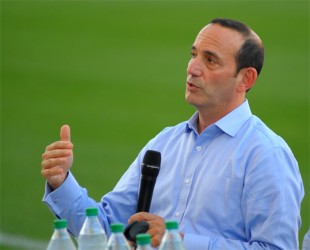Photo Earl Gardner
In his end-of-season press conference, Sporting Director Ernst Tanner stressed maintaining “roster flexibility” as a constraint on negotiating with veteran players whom he had wanted to bring back, e.g., Alejandro Bedoya (since re-signed), Jack Elliott (since departed to Chicago), and Brandan Craig (since cleared waivers current status unknown). “Roster flexibility” almost certainly meant the salary cap.
The salary cap numbers change yearly under the Collective Bargaining Agreement (CBA), increasing annually. As we observe, navigate, and otherwise analyze the Philadelphia Union’s 2025 roster build, the following compensation numbers from the current CBA may be useful, both individual and collective.
To review, the League holds all contracts. Officially, the league pays all players on the senior roster (slots 1-20). The club pays the players on its supplemental roster (21-30).
The supplemental roster is subdivided into the senior slots (21-24) with no upper limit on age and the reserve ones (25-30), for which a player must be 24 or younger at some point during the year.
Additionally, if a club carries three goalkeepers, it can have an additional supplemental reserve slot (31). Still, the player in that slot must be sent on a year-long, unrecallable loan to its MLS Next Pro team, as homegrown defensive midfielder Nick Pariano was in 2024.
Individual player compensation minimums
We first address individual minimums, typically the first contracts of Philadelphia Union homegrowns who are not Cavan Sullivan. Then, we look at aggregate and individual upper limits and the major loopholes through the upper limits.
For 2025, the minimum salary of the MLS Reserve Roster will be $80,622. Neil Pierre would get at least this much if signed during the offseason as a 2025 homegrown, but we suspect he will probably get somewhat more. Frank Westfield is more likely to get the minimum if he is also signed. Last season, Andrew Rick, David Vazquez, and CJ Olney all got 2024 minimums, and then Rick and Olney added some bonus money (explained further down).
The 2025 MLS Senior Roster minimum salary is $104,000. In 2024, Chris Donovan and Oliver Semmle received 2024’s senior roster minimum.
As previously mentioned, the lesser-salaried players received bonuses based on the bonus scale we detail next. We assume higher salaried players have individually negotiated bonuses and other provisions for good performance structured into their contracts. After 2023, Daniel Gazdag’s and Jose Martinez’s performance data activated contract options, as did Mikael Uhre’s performance data after 2024.
Bonuses
For years 2020-2026, any player on an MLS roster earning a base salary from the Senior Minimum Salary up to $35,000 above will receive the highest achievable of the following bonuses for being included on the gameday roster, playing or starting in an MLS game (Regular Season and MLS playoffs):
- Game Day Roster Bonus: $500
- Playing Bonus: $750
- Starting Bonus: $1,000
A Reserve Player earning a base salary below the Senior Minimum Salary will receive the highest achievable of the following bonuses for being included on the gameday roster, playing or starting in an MLS game (Regular Season and MLS playoffs), up to but not exceeding the Senior Minimum Salary: For years 2020-2026:
- Game Day Roster Bonus: $250
- Playing Bonus: $750
- Starting Bonus: $1,500
Andrew Rick is a Reserve player who would have earned the most from these bonuses for 2024 with six starts and six other game-day rosters. His reserve roster minimum salary (c. $71 K) was given as c. $79 K at the close of the Secondary Transfer Window in mid-September. We infer the increase reflects his bonuses.
2025 Salary Cap Aggregates and Limits
This section will read like a foreign language vocabulary list being memorized half an hour before the daily vocabulary quiz.
TAM is Targeted Allocation Money. GAM is General Allocation Money. GAM’s usage is more versatile than TAM. TAM is being reduced annually. GAM is increasing, presumably to compensate.
The MLS salary cap is a “soft” cap in layman’s terms. There are loopholes through it. (We will not know 2025 annualized base salaries until roughly a month after the 2025 Primary Transfer Window closes, as yet unannounced but estimated to be towards the end of April. So we counterfactually use 2024 data to illustrate.)
For 2025, the soft cap’s loopholes are four: Designated Players, U22 Initiative players, TAM players, and Homegrown subsidy players. Clubs can now choose among two ways to arrange their loopholes. For the first two groups, now being called special players, clubs may have either three DPs and three U22s, or two DPs, four U22s, and $2 million extra of GAM.
- Designated players can be paid more than the Individual Maximum Salary Budget Charge ($743,750 in 2025) by the club itself, subject to league approval of the deal. (See Lionel Messi, $12 M, etc.)
- U 22 initiative players must satisfy age requirements to be eligible, as the name implies. Then they will have their charges against the salary cap reduced to a fixed amount, with the club responsible for paying the difference (in 2025, see Quinn Sullivan almost certainly, and Olwethu Makhanya definitely.)
- TAM players are those whose annualized base salary falls between an annually calculated maximum limit and the minimum, which is the maximum individual salary budget charge ($743,750 for 2025). They may then have their annual salary budget charge bought down by the payment of TAM back to the league.
- As of New Year’s Day, for 2025 the Union has five TAM players: Kai Wagner ($875 K), Danley Jean Jacques (probably covering his transfer fee in some fashion since his 2024 salary did not exceed the maximum individual salary budget charge), Jakob Glesnes ($1.0 M), Andre Blake ($800 K), and Tai Baribo (probably still covering his 2023 transfer fee in some fashion since his 2024 salary did not exceed the maximum individual salary budget charge). In the parentheses above, we have given the annualized base salary as of September 23, 2024, for each player. For 2024, $683,750 was the maximum salary budget charge for a player at least 24 years old.
- To illustrate very roughly 2024’s upper limit to the buy-downs, Mikhael Uhre’s $1.8 million salary was too high. He could not be bought down. Daniel Gazdag’s $1.6 million was not, and he could have been, and probably could be, for 2025 were that move to become necessary.
- The lower buy-down limit refers to the Maximum Salary Budget Charge for the respective year. In 2024, this amount was $683,750, while in 2025, it will be $743,750.
The soft cap number for 2025 is $5,950,000 per team salary budget. But to reiterate the soft cap has four loopholes through it.
The minimum per team GAM amount for 2025 is $2,930,000. It is increasing annually under the current CBA.
Each club’s annual chest of GAM can be increased in a variety of ways. Philadelphia’s has been announced as $4,220,769 and will almost certainly increase to $6,220,769 on roster compliance day (assumed to be February 21, 2025). Glavinovich’s loan fee to Newell’s Old Boys is thought likely to reduce the total available as will the five TAM players.
Parenthetically, GAM may also be used to buy down a player’s salary cap charge as in the manner of TAM. Still, in any given year the two types of “Garber Bucks” may not be mixed for use against a specific single player’s salary charge. To illustrate concretely with a fictional – repeat, fictional! – hypothetical, Kai Wagner’s buy down would have to be all TAM, while Jakob Glesnes’s would have to be all GAM, … or vice versa.
The annually shrinking TAM amount per team for 2025 is $2,225,000. We think we know that TAM is being phased out because originally, it was created to force clubs to spend more money for better players. Thus, it restricted a club’s flexibility and circumscribed its philosophy. The restriction and circumscription are now being phased out.
The Maximum Salary Budget Charge for an individual player in 2025*is $743,750* in the CBA. If you decide to read the CBA for yourself, you must translate a catch, as follows.
* “The Maximum Salary Budget Charge may increase in the event the Team Salary Budget increases in accordance with Section 10.11 (Incremental Media Revenues), provided that the Maximum Salary Budget Charge will not exceed twelve and one-half percent (12.5%) of the Team Salary Budget.”
We take that to mean the CBA was negotiated before the Apple media rights deal was finalized and the language allows for sharing the fruits of that deal with the players. We cannot tell whether such sharing will occur in 2025.
Finally, note that one player cannot get more than 1/8 of a team’s salary budget (unless he is Lionel Messi, of course). MLS rules always apply to everybody, … until they don’t.
Appendix: Accessing the current CBA for oneself
The Major League Soccer Players Association (MLSPA) provides a copy of the current CBA on its website under the heading “Resources” (the same place that has its Salary Guides). Click here.
The first pages are the Table of Contents. Look for the subject headings that may contain what you seek and scroll to those pages on the left column.
So that you know, you will be reading prose written by lawyers for other lawyers. It can be dense. We have only gotten as far as we have by looking for concrete illustrations in the details of the Union’s roster.


Tim, thank you for all of your roster/salary articles. As much as I use these comments to vent frustrations, I do appreciate the analysis and learn something every time.
–
So a question – what happens to unused TAM/GAM in a given year? We know future GAM can be traded, but can unused GAM be rolled into the next season? Or if it isn’t used is it just forfeited? Seeing the direction the club is going this season, it seems impossible they will use over $6MM of GAM.
Tim, I want to echo nagjs1’s comment. I appreciate the article that try to undo the knot that is the MLS salary structure. I would fail an exam on the basics of TAM/GAM/DP/etc., but I very much appreciate your efforts to educate the PSP readers.
+1!
The U are in trouble with FIFA and have been banned for the next 3 transfer periods from registering new players over pretty much $700… https: //www. inquirer. com/soccer/philadelphia-union-transfer-ban-fifa-jose-riasco-20250113.html
The joke was all over social media, but little impact is expected because Union had no plans to sign any new players.
It sounds like the Union made significant effort to pay the youth club in Venezuela but couldn’t get in contact with the right people there. Ending up on FIFA’s naughty list for $700 isn’t a good look, but I don’t blame the FO on this one. Ideally, all the paperwork and admin stuff gets done quickly before the 1/31 transfer window opening.
.
Hopefully they do plan on bringing in more talent. I’m worried they’re going to point to the new facility and say all the money is tied up in that investment.